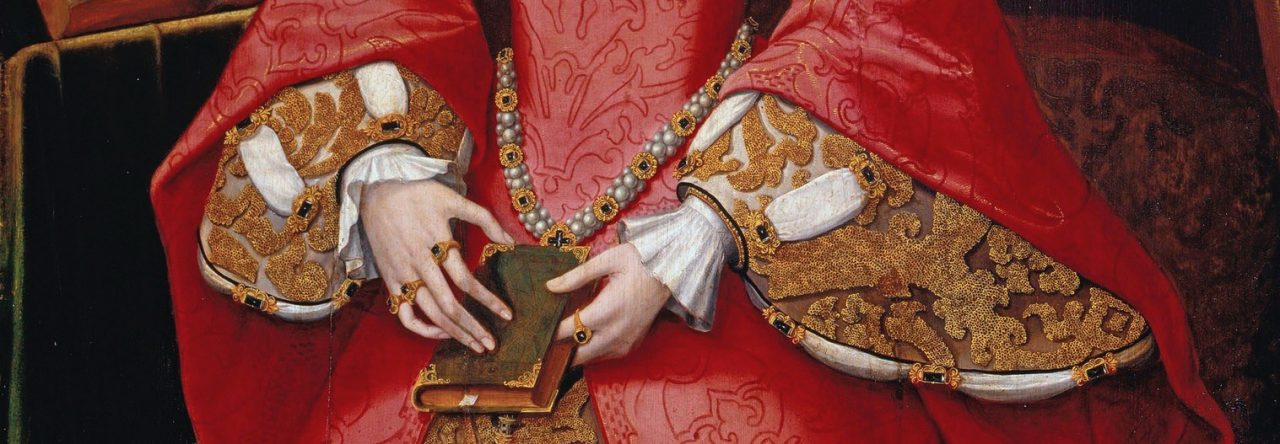By Mark Byford
The gift of a Bible in the early modern period was always an important mark of care and/or respect for the person it was given to, since in an avowedly Protestant country it was seen as holding the keys of salvation. This book was bought as just such a gift for an early modern woman, retaining the inscription recording this act on the front pastedown: “The gift of John Cleobury parson of Burford to the Lady Anne Cornwall, 1619.”

Cleobury had been made rector of Burford in Shropshire following the death of his predecessor a few years earlier in 1614. Lady Anne was born the daughter of Sir Gilbert Littleton, who lived at Frankley, thirty miles away in Worcestershire. By the time she received this Bible, she was around forty-five years old and had spent much of her life in Burford, having married Cleobury’s patron, the Baron of Burford, Sir Thomas Cornwall, many years earlier, and borne him no fewer than twelve children.
This Bible was no ordinary gift. It was printed in 1618, just seven years after the first printing of the translation which we often describe as the “King James Bible” or the “Authorised Version.” At this point the new translation, which was to become the most famous of all English versions, was still establishing itself in the godly community where the Geneva version of the Bible had for so long provided what they saw as the best Bible text. So it may have been seen by Anne as an object of curiosity and interest, containing an unfamiliar recounting of very familiar and vitally important texts. The donor’s reverence for the object, or perhaps for its owner, was underscored by the binding which, although it is now a shadow of its former self, was clearly of exquisite quality. With gilded edges, gauffred with flower patterns, its covers were elaborately decorated with flowers and plants composed of silver thread and coloured silks, sewn onto a cream silk ground, and held closed with elaborate silk ties. Restored recently by James Brockman, it is now housed in a purpose-made box crafted by him specifically to protect its delicate binding from further damage.
Such books were high-status objects in Jacobean society, often revered for what they represented, rather than necessarily being used. As a result, modern collectors can sometimes find such Bibles disappointingly pristine inside, lacking any evidence that gives clues about the importance of the text for its owner. This is not the case here, however. Anne Cornwall took the trouble to sign her name twice, once on the first page of Genesis, and once opposite the title page to the New Testament.
And it is clear that she used the Bible for the daily cycle of worship prescribed in the Book of Common Prayer, as well as for regular Bible reading, often with important passages highlighted.
In terms of worship, Anne has noted in the Book of Psalms within the Bible which of the psalms was indicated to be read or sung for morning and evening prayer through the thirty-day cycle indicated in the Book of Common Prayer. She may have used this for her personal devotions or to follow the service in Church.

Judging from her markings, most of Anne’s reading was focused in the New Testament. That said she also carefully read through the Book of Isaiah, the prophet who most clearly foretold Jesus’ birth, and who was described from at least the time of St Jerome onwards as “the fifth evangelist.” Many of its verses supplied important insights marked with a small hand, or manicule, in the margin. When it comes to the Gospels, Anne appears to use her pen differently, marking each verse as she read it, and perhaps reflected on what it had to tell her, as witnessed in this opening from St Matthew’s gospel.

Anne was not to die until 30th January 1656/7, buried in the chancel of Eastham some six miles from Burford, where the funeral slab records her as being 87 years old. Her husband Thomas had died many years before in 1635. Yet just over twenty-five years earlier, in 1630, they had commissioned a monument in Burford church, with the inscription recording that, “These statues represent now living the son of Sir Thomas Cornwall knight and Anne his lady daughter of Sir Gilbert Littleton, of Frankley in the County of Worcester, by whom he hath issue Richard Cornewayle, Sir Gilbert Cornewaylle, Knight, Thomas, George, Robert, James and Alfred Cornewaylle, twins and five daughters videlicet [namely] Katherin, Mary, Ann, Elizabeth, Margaret. This memento was made by Sir Thomas Cornwaylle, Kt., in the year of our Lord God 1630, and in the year of the age himself 58 and of his lady 56.” The arithmetic respecting Anne’s age differs between this monument and the one in Eastbury, but its power for us lies principally in the statues, still surviving after almost four centuries, and showing Sir Thomas and his wife at prayer, their Bibles open before them.

Source: book in private collection. Photos of the book by Mark Byford, reproduced with permission.










Pingback: Monro, Sermons Preached upon Several Occasions (1693) – Early Modern Female Book Ownership